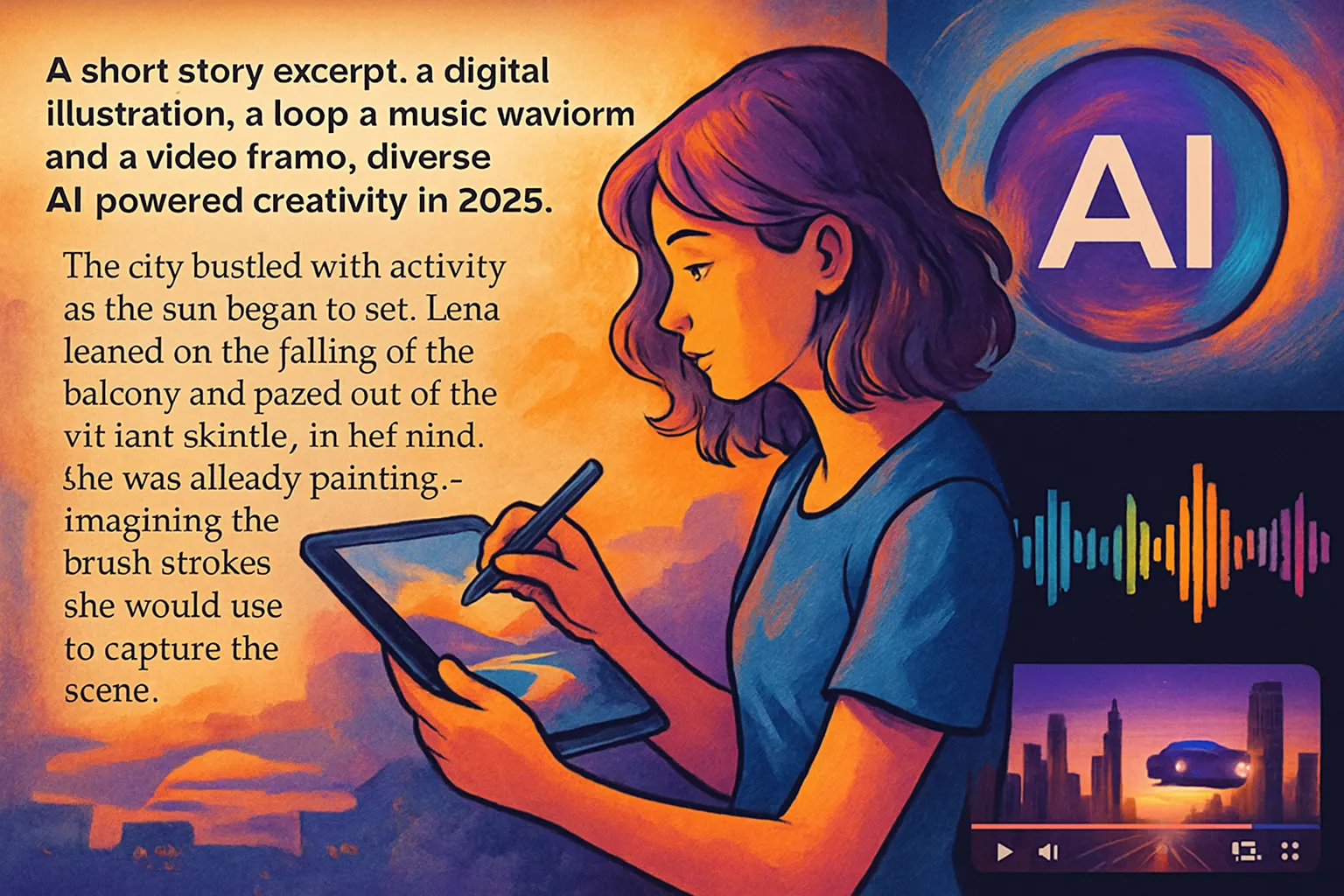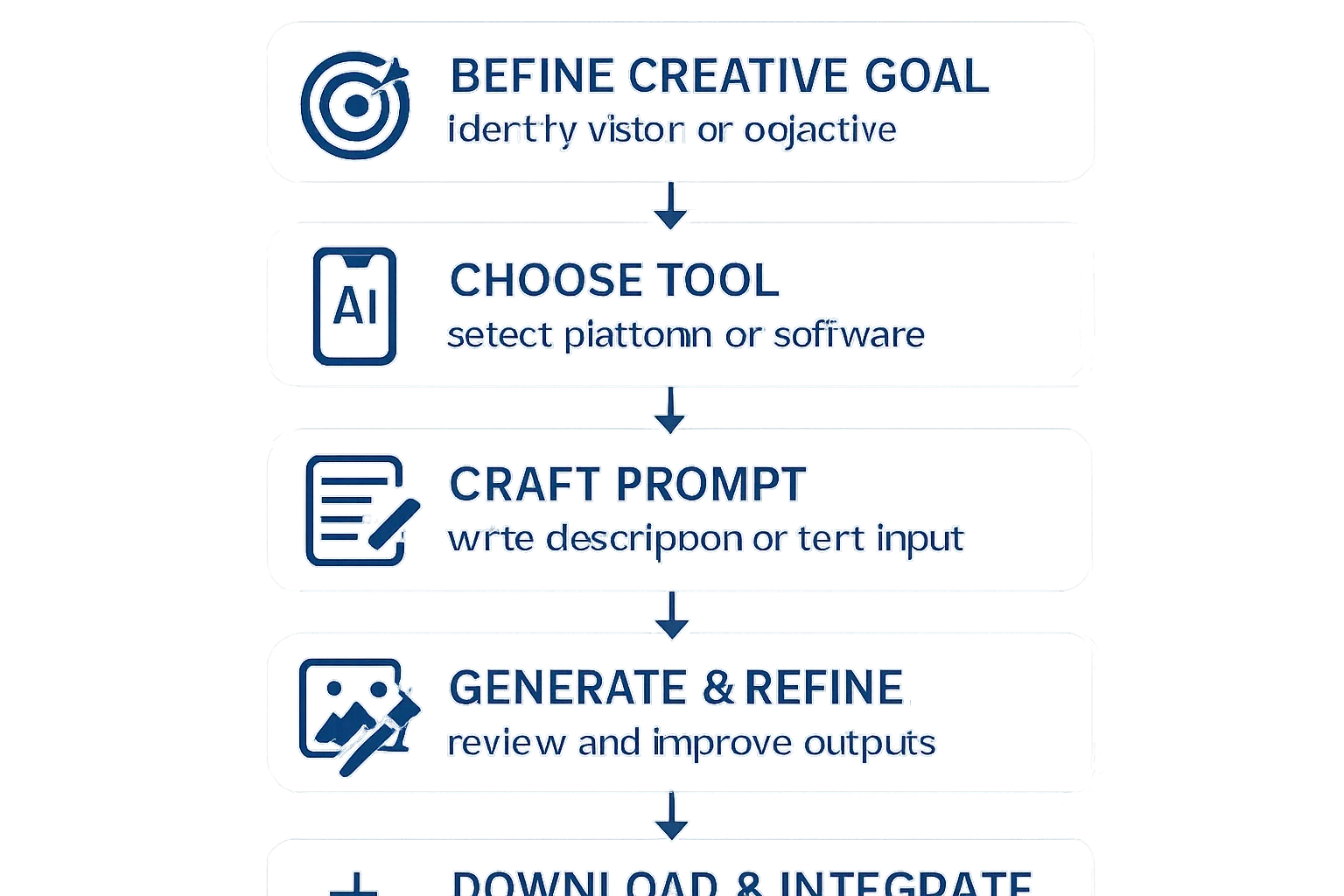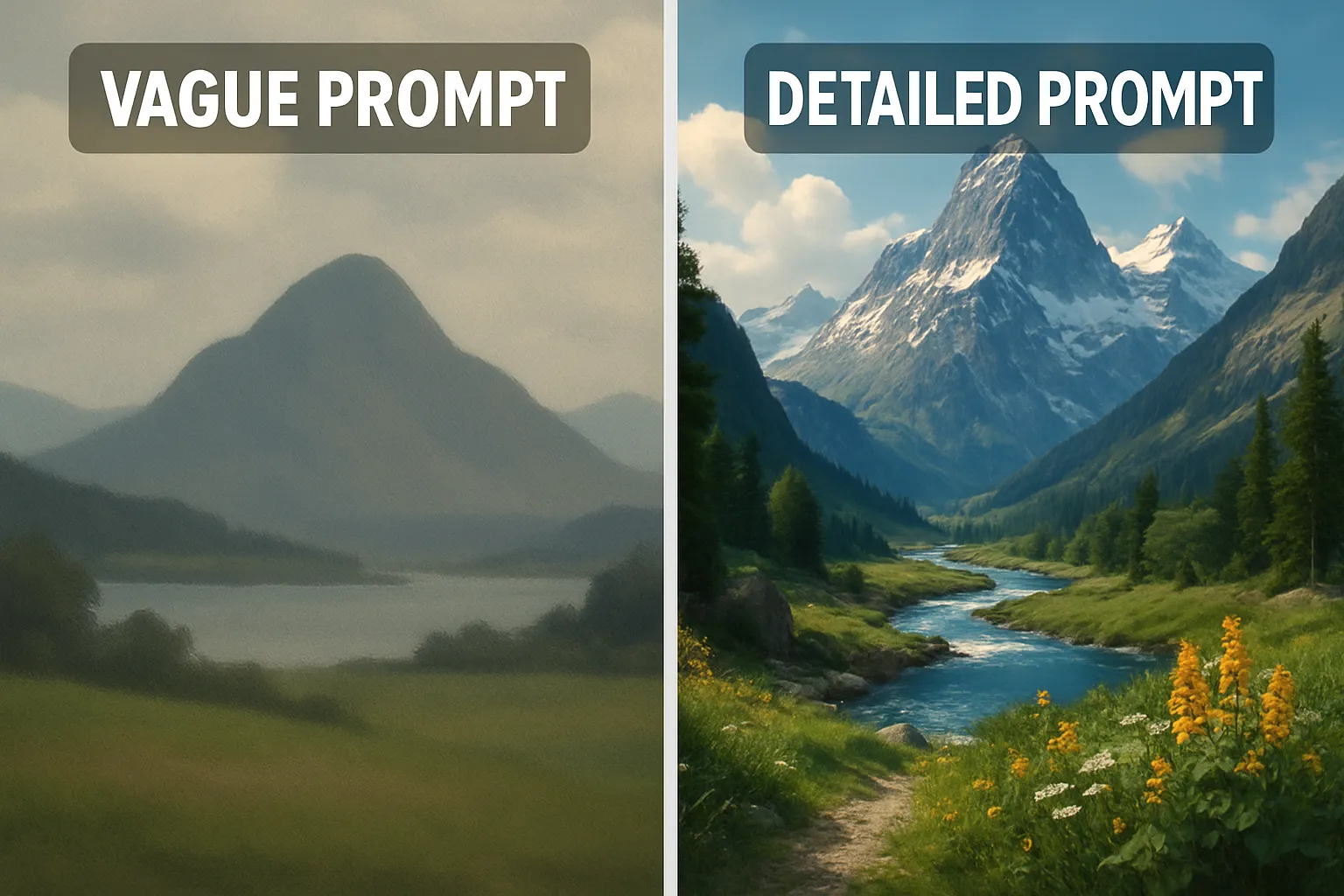Introduction: The Rise of AI Generators for Creative Projects
The creative landscape is experiencing a seismic shift, thanks to the rapid evolution of AI generators. What began as experimental tools for automating repetitive tasks has blossomed into a full-fledged creative revolution. In just a few short years, AI generators have matured from simple text or image generators into sophisticated platforms capable of producing art, writing, music, design, and even complex video content - all from a single prompt.
By 2025, AI-driven creativity has reached a pivotal moment. The latest generation of AI generators is not only more powerful and accessible but seamlessly integrated into the everyday workflows of artists, designers, writers, marketers, and entrepreneurs. This year marks a turning point where AI is no longer just a futuristic concept; it’s an essential partner in the creative process, helping professionals and hobbyists alike to break through creative barriers, explore new mediums, and accelerate their projects from idea to execution.
In this comprehensive guide, you’ll discover:
What an AI generator is, and how it works
How to harness AI for creative writing, art, and design
Practical examples of AI-powered creativity in action
The top recommended AI tools for 2025
Proven strategies to stay ahead of the curve in this fast-moving field
Whether you’re a tech-savvy professional, a digital marketer, a developer, or an AI enthusiast, this guide will empower you to unlock the full potential of AI generators and supercharge your creative projects in 2025 and beyond.
What is an AI Generator? Demystifying the Technology
AI generators are advanced tools that use artificial intelligence to create original content based on user input. At their core, these systems leverage machine learning algorithms trained on massive datasets - millions or even billions of examples of text, images, audio, and video. When you provide a prompt, the AI analyzes your instructions, references its training data, and generates a new, unique output that matches your request.
The essential components of any AI generator include:
Machine Learning Models: These are the brains behind the operation, capable of understanding patterns in data and generating new content.
Large, Curated Datasets: These datasets teach the AI what text, images, audio, or video should look and sound like.
Prompt-Based Outputs: Users simply describe what they want, and the AI generator brings it to life - whether it’s a story, an illustration, a song, or even a short film.
AI generators now support a diverse range of creative outputs, including:
Text: Articles, stories, poems, product descriptions, scripts, and more.
Images: Digital art, illustrations, graphics, logos, and photo edits.
Audio: Music tracks, sound effects, podcasts, and voiceovers.
Video: Animated clips, explainer videos, marketing content, and cinematic sequences.
Design: Layouts for websites, social media posts, presentations, and branding assets.
The journey of AI generators has been remarkably swift. In 2019, most creative AI tools were experimental or limited to niche applications. By 2021, breakthroughs like GPT-3 and DALL-E made generative AI accessible to a wider audience. Since then, the technology has rapidly evolved - integrating multimodal capabilities, improving output quality, and lowering the barrier for creative professionals and hobbyists alike. Now, in 2025, AI generators are mainstream, driving a new era of creative empowerment.
"A remarkable 83% of creative professionals have integrated generative AI tools into their workflows. Daily usage of AI creative tools has become the norm for 70% of professionals in creative fields." - Source
How AI Generators Work: The Technology Behind Creativity
AI generators are powered by a range of advanced models, each contributing unique strengths to the creative process:
Diffusion Models: These models, like Stable Diffusion and DALL·E, start with random noise and iteratively refine it to produce detailed, high-quality images or art based on prompts.
Generative Adversarial Networks (GANs): GANs use two neural networks - a generator and a discriminator - that compete to create increasingly realistic outputs, widely used for images, design, and even deepfake videos.
Transformers: The backbone of modern AI, transformers excel at understanding and generating text, powering language models like GPT-4 as well as multimodal models that blend text and visuals.
Variational Autoencoders (VAEs): VAEs encode data into a compressed form and then reconstruct it, enabling smooth, diverse outputs for both images and audio.
How Prompts Are Processed
When you enter a prompt, Natural Language Processing (NLP) algorithms break down your request to understand intent and context. In text-to-image or text-to-audio generators, the system translates your words into a set of instructions, which guide the AI model to produce the desired output. For example, a prompt like “a futuristic cityscape at sunset in watercolor style” is analyzed for key elements - scene, time of day, and artistic style - before generating the final artwork.
The Workflow: From Input to Output
Input: You provide a prompt describing what you want to create.
Processing: The AI model interprets the prompt using NLP and maps it to its training data.
Generation: The AI synthesizes new content - text, image, audio, or video - based on its understanding.
Output: The result is delivered in seconds, ready for use or further editing.
Real-World Example: Creating AI-Generated Art
Suppose you want to create an original digital artwork. You enter a prompt like, "A serene mountain landscape at sunrise, in the style of Japanese ink painting." The AI processes your request, references its dataset of landscapes and Japanese art, and generates a brand-new image that matches your description. Similarly, for writing, a prompt like "Write a short story about a robot discovering music" yields a unique, creative narrative.
"By 2024, models based on the Stable Diffusion platform had generated over 12.5 billion images, making it the leading AI art generator." - Source
Popular Use Cases: Creative Projects Powered by AI Generators
AI generators have revolutionized creative workflows across a wide range of fields. Here are some of the most popular ways people are harnessing AI for innovative projects in 2025:
Writing: AI helps craft compelling stories, blog posts, scripts, and even poetry. Authors and marketers use generators to brainstorm ideas, co-write novels, and automate content creation for websites and campaigns.
Art & Design: From detailed illustrations and custom logos to eye-catching posters, AI art generators empower designers and entrepreneurs to produce professional visuals on demand. Artists use AI to experiment with new styles and techniques, bringing their visions to life faster than ever.
Music & Audio: AI-driven tools compose original soundtracks, jingles, and even full albums. Musicians and content creators rely on AI for sound design, background music, and voiceovers - making high-quality audio production accessible to all.
Video: Animated shorts, explainer videos, and promotional clips can now be generated from simple prompts. Businesses and educators use AI video tools to rapidly produce engaging content for social media, training, and marketing.
Practical Examples from 2025
A novelist uses an AI generator to outline and draft the first chapters of a sci-fi story, iterating ideas in minutes.
A startup founder creates a complete brand identity - including logo, color palette, and social media banners - using AI design tools.
A YouTube creator produces an animated explainer video with AI-generated script, narration, and music, all within a single afternoon.
An indie game developer composes a dynamic soundtrack and generates unique sound effects using AI music generators.

Step-by-Step Guide: How to Use an AI Generator for Your Project
Define Your Creative Goal
Start by clarifying what you want to achieve - whether it’s writing an article, designing a logo, composing music, or producing a video. Knowing your end goal will help guide every step of the process.Choose the Right AI Generator/Tool
Research and select an AI tool that specializes in your desired output. For example, use TopTool to discover the best AI writing, art, or music generators suited to your project.Craft an Effective Prompt
Write a clear, detailed prompt that tells the AI exactly what you need. The more specific your instructions, the better the results - describe style, tone, length, or any must-have elements.Generate, Review, and Refine Outputs
Let the AI create your content, then carefully review the results. If it’s not quite right, tweak your prompt or try different settings until you’re satisfied.Download, Edit, and Integrate into Your Project
Save the final output, make any additional edits, and incorporate it seamlessly into your workflow - whether that’s publishing, presenting, or sharing with your team.
Tips for Best Results
Experiment with prompt variations to find what works best.
Use reference examples or style guides if your AI tool allows.
Don’t be afraid to iterate - refinement is key to quality.
Check usage rights for commercial projects.
Avoid vague prompts and always double-check AI-generated facts or data.

Top Recommended AI Generators for Creative Projects in 2025
Choosing the right AI generator can supercharge your creative workflow. Here’s a curated selection of the best AI tools for writing, art, music, and video in 2025 - each offering unique features and value for creative professionals and enthusiasts.
Leading AI Generators by Category
Writing
ChatGPT (OpenAI): Industry-leading conversational AI for stories, blogs, and scripts. Integrates with plugins and offers advanced prompt engineering.
Pricing: Free tier, $20/month for Plus
Best for: Writers, marketers, studentsJasper: Optimized for marketing copy, long-form content, and SEO.
Pricing: From $39/month
Best for: Content marketers, agencies
Art & Design
Midjourney: High-quality, artistic image generation via Discord.
Pricing: From $10/month
Best for: Artists, designers, illustratorsDALL·E 3 (OpenAI): Detailed, prompt-based art generation with powerful editing.
Pricing: Free limited, included in ChatGPT Plus
Best for: Businesses, creators, educatorsCanva AI: Integrated design and image generation with templates and editing tools.
Pricing: Free, Pro from $12.99/month
Best for: Social media, presentations, branding
Music & Audio
Suno AI: Text-to-music composition in multiple genres.
Pricing: Free tier, paid plans available
Best for: Content creators, musicians, marketersBeatoven.ai: Custom mood-based, royalty-free music generation.
Pricing: Free tier, paid per minute
Best for: Video producers, podcasters
Video
Runway ML: Text-to-video, video editing, and effects for creators and teams.
Pricing: Free limited, paid from $15/month
Best for: Marketers, educators, video prosArcads: AI-generated UGC-style ads for social media marketing.
Pricing: Custom, based on usage
Best for: Advertisers, social media managers
Comparison Table: Top AI Generators for Creative Projects
Name | Type | Features | Pricing | Best For |
|---|---|---|---|---|
ChatGPT | Writing | Advanced text, stories, scripts, plugins | Free, $20/mo Plus | Writers, marketers, students |
Jasper | Writing | SEO, long-form, marketing copy, team tools | From $39/mo | Content marketers, agencies |
Midjourney | Art | Artistic, high-res images, Discord-based | From $10/mo | Artists, designers, illustrators |
DALL·E 3 | Art | Detailed images, prompt editing, in ChatGPT | Free limited, $20/mo | Businesses, creators, educators |
Canva AI | Art/Design | Templates, image gen, editing, brand kit | Free, $12.99/mo Pro | Social, branding, presentations |
Suno AI | Music | Text-to-music, multi-genre, easy export | Free, paid plans | Content creators, musicians |
Beatoven.ai | Music | Mood-based, royalty-free, flexible licensing | Free, paid per minute | Video, podcasts, marketing |
Runway ML | Video | Text-to-video, editing, effects, collaboration | Free limited, $15/mo+ | Marketers, educators, creators |
Arcads | Video | UGC-style video ads, batch creation, lip sync | Custom, by usage | Advertisers, social media |
Practical Tips: Writing Effective Prompts for Better AI Results
Prompt engineering is the secret sauce behind outstanding AI-generated content. The way you phrase your request can make the difference between a generic, uninspired output and a result that matches your vision perfectly.
Why Prompt Engineering Matters
AI generators rely on your instructions to create content. The more specific, structured, and descriptive your prompt, the better the AI can understand your intent and deliver high-quality results.
Examples: Effective vs. Ineffective Prompts
Ineffective Prompt:
"Make a picture of a dog."Effective Prompt:
"Create a detailed digital painting of a golden retriever puppy sitting in a sunlit meadow, surrounded by wildflowers, with a joyful expression and soft, realistic fur."
Advanced Prompt Techniques
Specify style and tone:
"Write a playful, rhyming children’s poem about space travel in the style of Dr. Seuss."Set context or perspective:
"Generate a blog intro for tech-savvy entrepreneurs interested in AI trends."Control output format:
"List five actionable tips for designing an AI logo, each in one sentence."Use reference examples:
"Draw a logo inspired by mid-century modern design, using pastel colors and geometric shapes."
Resources for Learning Prompt Engineering

Integrating AI Generators into Your Workflow: Automation & Collaboration
Automation and collaboration are at the heart of next-generation creative workflows. By integrating AI generators with APIs and automation platforms, teams can streamline content production, reduce manual effort, and maintain consistency at scale.
Automate Creative Tasks with AI
APIs & Workflow Tools: Connect AI generators to your CMS, design suite, or project management tools using APIs or platforms like TopTool. Set up automated triggers - such as generating blog images when a draft is published, or auto-creating video clips for new product launches.
Batch Processing: Use AI to generate thousands of assets (articles, designs, product descriptions) in bulk, freeing your team to focus on strategy and quality control.
Seamless Editing: Automate handoffs between AI and human editors for review, feedback, and final tweaks.
Collaboration Between Humans and AI: Best Practices
Set Clear Roles: Use AI for ideation, first drafts, and repetitive tasks; reserve human expertise for strategy, editing, and brand voice.
Iterative Feedback: Collaborate with AI by refining prompts and reviewing outputs together, ensuring results meet your creative standards.
Transparency: Communicate which parts of content are AI-generated for team alignment and compliance.
Case Study: Scaling Content Creation with AI in 2025
"A leading e-commerce company saw a 113% increase in blog output after automating initial drafts with AI, allowing their small marketing team to double content production and focus on high-impact strategy." - Source
Other brands like Adore Me and Alibaba have saved thousands of hours annually by automating product copy, while agencies like Journey Engine now deliver high-volume, in-depth blog posts with minimal manual effort - all without sacrificing quality.
Benefits: Speed, Scalability, Consistency
Speed: Generate creative assets in seconds, not days.
Scalability: Effortlessly handle large projects and campaigns.
Consistency: Maintain brand standards and messaging across every piece of content.
AI-powered automation and collaboration are redefining what creative teams can achieve - empowering professionals to do more, faster, and with greater impact.
Potential Challenges and Ethical Considerations in Using AI Generators
As AI generators become mainstream for creative projects, it’s essential to be aware of the challenges and ethical issues that come with their use:
Copyright and Originality Concerns
AI-generated content often draws upon massive datasets that include copyrighted materials. This raises questions about the originality of outputs and who truly owns the rights to AI-created works. Always review the terms of service for your AI tools and ensure you have the rights to use and commercialize generated content.
Bias and Fairness in Generated Content
AI models can inadvertently reproduce or amplify biases present in their training data. This may result in outputs that reinforce stereotypes or exclude certain perspectives. To foster fairness, review AI-generated content critically and, where possible, choose tools that prioritize diverse and ethical training practices.
Managing Quality and Avoiding Over-Reliance
While AI excels at rapid content creation, it can sometimes produce generic, inaccurate, or low-quality results. Relying too heavily on AI may dilute your creative voice or lead to errors slipping through. Always review, refine, and supplement AI outputs with human expertise.
Tips for Responsible and Ethical Use
Use AI as a creative partner, not a replacement for human judgment.
Fact-check and edit all AI-generated content before publishing.
Be transparent about your use of AI, especially in professional or commercial contexts.
Stay informed on evolving copyright and ethical guidelines.
Choose reputable AI tools that prioritize data privacy, consent, and inclusivity.
By staying vigilant and ethical, you can harness the power of AI generators while protecting your creative integrity and respecting the rights of others.
Conclusion: Start Exploring AI Generators with TopTool
AI generators are redefining what’s possible in creative industries - accelerating workflows, unlocking new artistic possibilities, and empowering individuals and teams to bring their boldest ideas to life. From writing and design to music and video, the practical benefits of AI-driven creativity are now within reach for everyone.
TopTool is your gateway to this exciting future. As the most comprehensive directory for discovering, submitting, and promoting the latest AI tools and startups, TopTool helps you stay ahead of the curve. Whether you’re searching for the perfect AI generator, looking to promote your own project, or eager to connect with a global community of innovators, TopTool makes it easy.
Ready to take your creativity to the next level?
Browse our curated database of 26,000+ tools across 500+ categories
Submit your own AI-powered solution to gain visibility and backlinks
Promote your creative projects and join a thriving ecosystem of early adopters
Don’t miss out on the AI-powered creative revolution of 2025. Visit TopTool today and start exploring the future of creativity!


